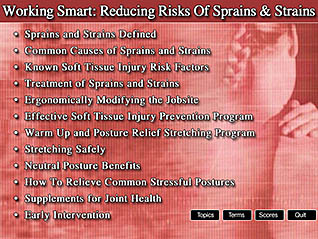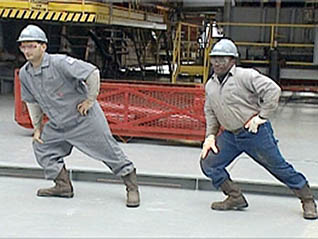Ergonomics: Working Smart: Reducing Risks of Sprains & Strains

- Product ID
- moxiwsrs
- Training Time ?
- 73 to 146 minutes
- Language(s)
- English
- Video Format
- Standard Definition
- Required Plugins
- MasteryNet Player
- Lesson Interactions
- 14
- Quiz Questions
- 40



This training, which is the last of a five part Employee Health and Wellness training series, concentrates attention on joint, ligament, muscle, and tendon strains, often referred to as soft tissue injuries. These are considered common disorders in today's workplace.
Painful sprains and strains that slow us down can lead to scar tissue, arthritic damage to the body, and serious disability. Expert Dr. Bunch describes how the human body should be maintained and properly "warmed up" on a daily basis. Learners see how this regimen becomes instrumental in slowing down the aging process by helping to preserve the integrity and health of the body's joints.
Dr. Bunch uses a valuable on-the-job stretching program to describe how employees can prevent muscle imbalances and weakening of tissues that can increase their vulnerability to unnecessary sprains, strains and joint injuries through a greater understanding of key ergonomic principles. He also discusses the effective medical management of employee soft tissue disorders.
![]() This course is in the Advantage™ format, to read about Advantage™ features click here.
This course is in the Advantage™ format, to read about Advantage™ features click here.

- Install on any SCORM LMS
- Rich multimedia presentation with interactions and quiz
- Print certificate and wallet card
- You have 30 days to complete the course
All workers.
-
Sprains and Strains Defined
- Sprains
- Strains
-
Common Causes of Sprains and Strains
- Conditions caused by muscle strains
- Common causes of sprains and strains
- Collagen
- Repetitive motion
- Bad postures
-
Known Soft Tissue Injury Risk Factors
- Risk factors for sprains and strains
- Stretching and strengthening
-
Treatment of Sprains and Strains
- RICE
- Rehabilitation
- Scarring
-
Ergonomically Modifying the Jobsite
- Employer's role
- Industrial athletes
- Employees roles
- Sound workplace ergonomics
-
Developing an Effective Soft Tissue Injury Prevention Program
- Soft tissue injury prevention program
- Ergonomic tools
- WUPR
- PSA
-
Warm Up and Posture Relief Stretching Program
- Relieving stress caused by an awkward posture
- Overhead reaching
- Bending exercises
- Synovial fluid
-
Stretching Safely
- Describe pre-job warm ups
- Arthritis prevention
- If stretching your back causes pain
-
Neutral Posture Benefits
- Extending the neck
- Dizziness with neck stretches
- Sleeping on stomach
- Neck and back exercises
-
How To Relieve Common Stressful Postures
- Torn rotator cuff
- Carpal tunnel syndrome
- Back extension stretches
-
Supplements for Joint Health
- Glucosamine and Chondroiten Sulfate
- Hydrophilic
-
Early Intervention
- Pain while performing job task
- Dr. Bunch's injury prevention program
-
Be aware of sprains and strains.
- Define a sprain.
- Define a strain.
-
Know common causes of sprains and strains.
- List conditions caused by muscle strains.
- List common causes of sprains and strains.
- Define collagen.
- Explain how repetitive motion can cause injury.
- Explain how bad posture can lead to sprains and strains.
-
Be aware of soft tissue injury risk factors.
- List risk factors for sprains and strains.
- Explain how stretching and strengthening can help you avoid sprains.
-
Understand the treatment of sprains and strains.
- Define RICE.
- Explain what should follow initial treatment of a sprain or strain.
- Recognize that moving strained tissue is likely to lead to scarring.
- Describe the process of rehabilitating a strained muscle.
-
Be aware of the workplace role in the prevention of sprains and strains.
- Explain the employer's role is preventing sprains and strains.
- Relate industrial athletes with professional athletes.
- Explain the employee's role is preventing sprains and strains.
- Discuss sound workplace ergonomics.
-
Be able to help develop an effective soft tissue injury prevention program.
- List what is included in a soft tissue injury prevention program.
- Discuss the use of ergonomic tools.
- Define the WUPR injury prevention program.
- Define PSA.
-
Utilize a warm up and posture relief stretching program.
- Discuss how to relieve stress caused by an awkward posture.
- Describe stretching techniques for overhead reaching.
- Describe stretching techniques for working while bent forward.
- Define synovial fluid.
-
Stretch safely.
- Describe pre-job warm ups.
- Explain how stretching before a job can help to prevent arthritis.
- Recall what to do if stretching your back causes pain.
-
Describe neutral posture benefits.
- Explain the consequences of extending neck to hold the head forward.
- Recognize dizziness with neck stretches could be serious problems.
- Explain why sleeping on stomach is not ergonomically correct.
- List neck and back exercises.
-
Relieve common stressful postures.
- Recognize rotator cuff injuries.
- Explain how carpal tunnel syndrome can be prevented.
- Explain reasons for back extension stretches.
-
Use supplements for joint health if needed.
- Discuss Glucosamine and Chondroiten Sulfate.
- Agree that water in cartilage cushions the body's movements.
-
Acknowledge the importance of early intervention.
- Describe what a worker should do if feeling pain performing task.
- Discuss Dr. Bunch's injury prevention program.
© Mastery Technologies, Inc.



